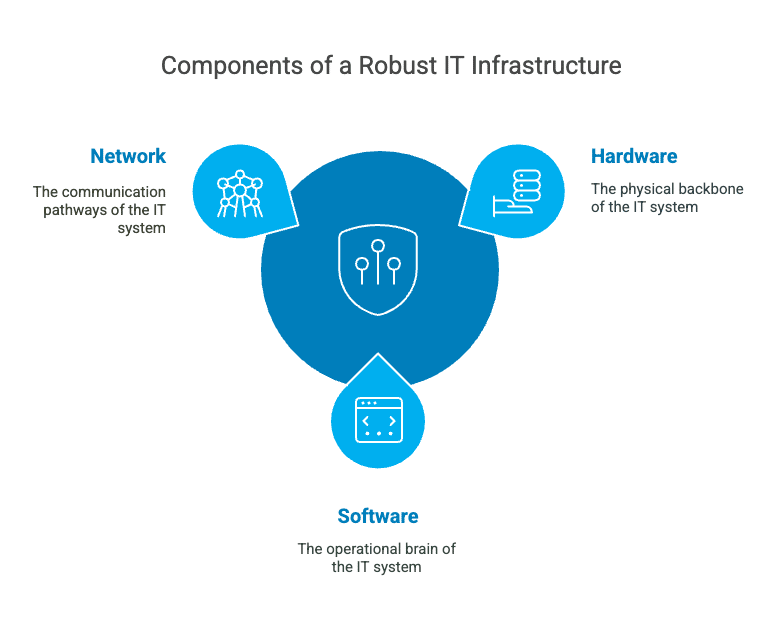Blueprint to Success: Building a Robust IT Infrastructure From Scratch
Imagine walking into an office and everything, from communications to operations, just… works. No slow loading screens, no “unexpected errors”, and no digital chaos. This is what happens when a business is powered by a solid IT infrastructure.
An effective IT infrastructure isn’t just a support system – it’s the backbone that ensures your business operates smoothly and efficiently. Your IT infrastructure is an essential framework that allows all your technology (computers, software, data storage, etc.) to work together harmoniously.
Building this framework from scratch might seem like a colossal task. But worry not – whether you’re a seasoned tech guru or a complete novice, this guide will unravel the complexities of IT infrastructure, and break them down into easily understandable and applicable pieces.
IT Infrastructure: Why is it so Important?
Emails, customer management systems, document storage – tools used every day in modern business. A robust infrastructure ensures that these operations run smoothly, minimizing downtime and keeping the digital wheels turning effectively.
Just having the digital tools isn’t enough; your IT infrastructure needs to be able to support them to operate reliably, and scale flexibly as your business needs demand. A well-designed IT setup will evolve with your business, accommodating and facilitating growth rather than being a bottleneck.
Core Components of a Robust IT Infrastructure
Building a robust IT infrastructure is like assembling a puzzle: each piece, or component, plays a vital role in creating the complete picture. The following broadly encapsulate all parts of infrastructure:

This is the tangible technology you can physically touch – computers, servers, routers, and more. Hardware is the skeleton of your IT setup, providing the structure on which everything else is built and organized.
Software is the brains of the operation, providing the applications and programs for your employees to work and deliver services to your customers. From email systems and communication platforms, to your network operating system and data storage, software encompasses all the tools that enable your business to execute its various tasks.
The network connects all the different parts of your business, ensuring data can travel smoothly from one point to another. Whether it’s an email from your team or a product purchase from a customer, the network ensures all devices in your IT infrastructure are able to communicate efficiently.
Assessment of Needs: Key Considerations
Building the ideal IT infrastructure begins with understanding your business’s unique needs and demands. This assessment isn’t just pivotal; it’s the foundation upon which your entire digital framework will stand.
Your work model defines where your team operates from – remotely, in-office, or a blend of both. Your IT infrastructure must cater to and support your work model to ensure seamless operations, whether your team is on-site or scattered across the globe.
This entails deciding where your data and applications will reside – within a physical location (on-premises), on the internet (cloud), or a mix (hybrid). Each option has its own pros and cons related to cost, accessibility, and security, making this a crucial decision point.
This involves overseeing and controlling your IT environment to ensure it runs smoothly and meets the business’s needs. Effective system management ensures optimal performance, security, and reliability of IT resources.
Scalability refers to the ability of your IT setup to grow and adapt to your business’s evolving needs. Planning for scalability ensures your IT infrastructure can accommodate future growth and changes.
The ability of your network to handle data and maintain performance. Adequate network capacity ensures uninterrupted operations and a positive user experience.
Resilience is the ability to maintain functions and quickly recover from IT disruptions or high traffic. Ensuring your network and systems are resilient and can handle high traffic will minimize downtime.
Budgeting: Cost-Effective Resource Allocation
Crafting an IT budget is the art of balancing what you desire with what you need, while ensuring the purse strings are kept in check. You need to allocate your monetary resources in a way that brings you the most bang for your buck.
Knowing your maximum available budget for IT infrastructure development and maintenance. Be realistic about your spending limits to avoid financial strains in other areas of your business.
Distribute your budget across various components like hardware, software, human resources, etc. Ensure each allocation aligns with your priorities and provides genuine value to your business operations.
Calculate not just the initial investment, but the ongoing costs of managing, maintaining, and upgrading the IT setup. TCO gives a realistic view of your IT expenditure over time, and helps avoid unforeseen financial burdens.
A contingency fund ensures financial readiness to tackle unforeseen challenges or leverage fresh opportunities without destabilizing your budget.
Periodically revisiting and adjusting the budget to reflect changes in your IT needs, market prices, and business financials keeps your budget relevant and realistic, ensuring alignment with your evolving business scenario.
Choosing and Implementing IT Infrastructure Components
With the budget setup and all key factors taken into consideration, it’s time to select the components of your IT infrastructure. Keep in mind that your entire IT ecosystem must work together, and the components need to complement each other to ensure unified operations.
For example, hardware should have the capacity and capabilities to host, run, and support software effectively. Likewise, the storage solution needs to be accessible via the network and secure at all times. This brings us to security – a component that must be intertwined with every other element, protecting data whether it’s at rest in storage, being processed by your software, or in transit across your network.
Once the components are chosen with integration in mind, the implementation phase is about bringing them together in a harmonious union. Ensure configurations are optimized for performance, security protocols are applied uniformly across the system, and data flows are efficient. Regular testing during this phase is crucial to identify and resolve any teething issues.
Potential Challenges and Possible Solutions
Building an effective IT infrastructure is a big task, and will doubtless present challenges. But with the right strategies, you can navigate through with minimal hiccups. Let’s delve into some common challenges you might encounter and explore pragmatic solutions.
Limited budgets may seem like a barrier, especially when quality IT infrastructure components come with a price tag.
Solution: Consider adopting a phased approach, gradually building your IT infrastructure over time. Explore financing options, utilize open-source solutions where possible, and prioritize spending to ensure critical aspects are funded first.
New technologies emerge at a rapid pace, and keeping your IT infrastructure relevant can be a constant battle.
Solution: Build with scalability and adaptability in mind. Choose components that can be easily upgraded and opt for software and platforms that actively keep pace with technological advancements.
Developing and managing IT infrastructure requires a certain level of expertise that might be lacking in-house.
Solution: Consider partnering with a managed service provider (MSP) who brings a wide range of expertise to the table. These professionals are experts in the IT field, and can help guide or even manage the entire process.
As your business grows, your IT infrastructure must scale accordingly, which can present logistical and financial challenges.
Solution: Opt for scalable solutions that will allow you to expand or contract capabilities as needed without a complete overhaul.
Your team may be unhappy with an overhaul of the systems, software, and processes they’re used to, as well as potential downtime as certain areas are upgraded.
Solution: Maintain continuous communication with your staff, partners, and stakeholders throughout the entire process. Arrange training for your staff so they can navigate the new environment confidently and securely.
Build an Effective IT Infrastructure with Expert Guidance From the Start
Building and managing IT infrastructure is an ongoing journey. As your business evolves, so will your IT needs. Continuous assessment, adaptation, and strategic planning will ensure your IT setup supports and propels your business towards its goals.
The expert team at Davenport Group is ready to guide you through the entire process – from initial assessments and budgetary planning, to implementing and integrating the new infrastructure, to employee training and ongoing support. Reach out to us today, and let’s get started on your blueprint to success.

